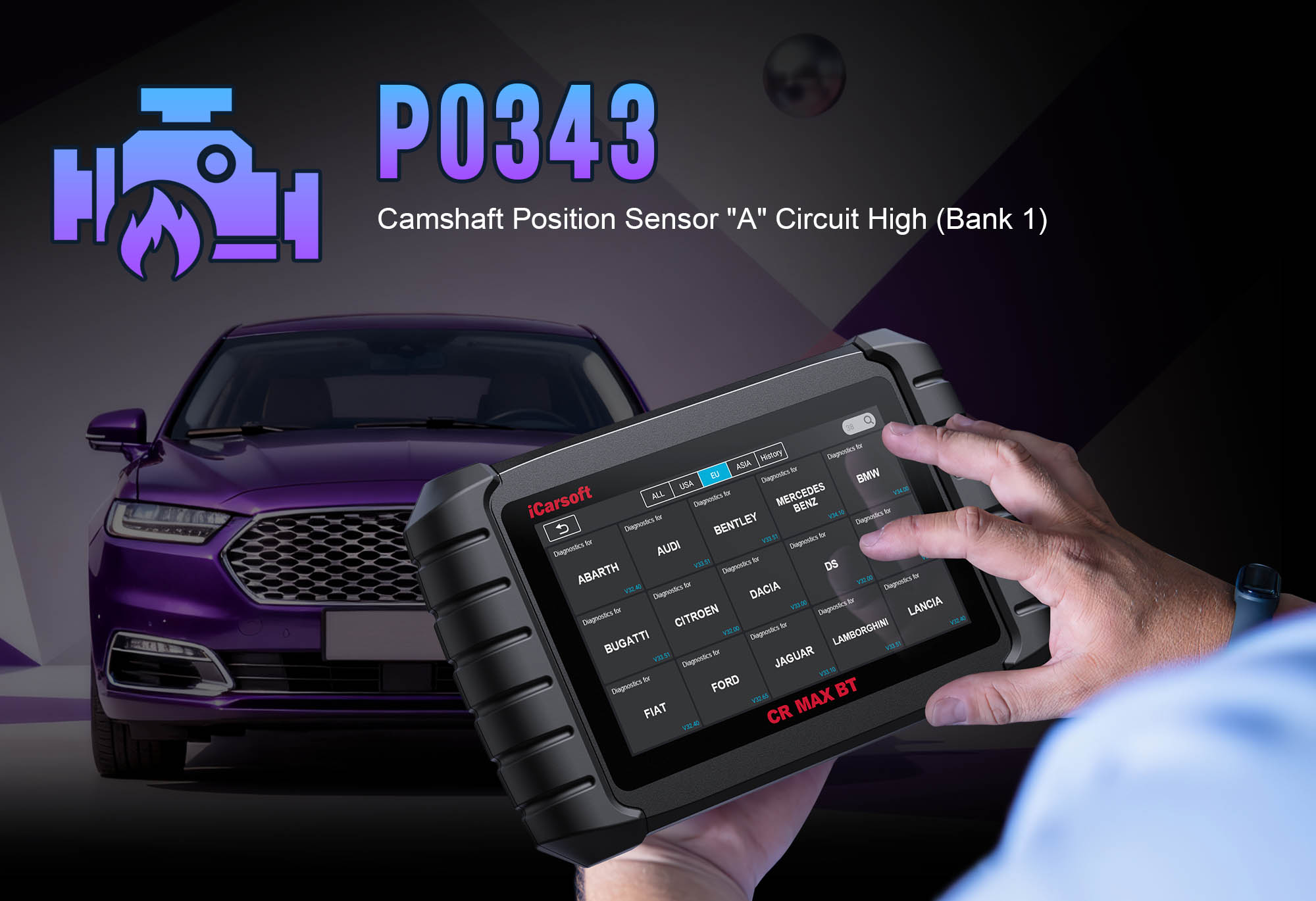Diagnose & Clear P0024 with iCarsoft CR MAX BT
If your vehicle’s check engine light illuminates, you notice rough idle, or it struggles with acceleration (especially at high RPM), a diagnostic scan will likely return P0024. This OBD-II code stands for "Camshaft Position Actuator ‘B’ Bank 1 Excessive Retard"—a fault targeting the variable valve timing (VVT) system’s camshaft actuator for Bank 1 (the cylinder bank containing the first cylinder in firing order). The Engine Control Module (ECM) uses the VVT actuator to adjust camshaft timing, optimizing fuel efficiency and power; when the actuator fails to advance the camshaft (instead keeping it in an overly "retarded" position, meaning valves open/close later than intended), P0024 triggers to alert you to timing misalignment that disrupts combustion.
Basic scanners might only flag a "VVT issue" but can’t test actuator responsiveness, verify oil pressure, or isolate electrical vs. mechanical faults—leaving you guessing between a faulty actuator, clogged oil passages, or wiring damage. The iCarsoft CR MAX BT, with its specialized VVT diagnostics, real-time camshaft timing tracking, and bi-directional tests, solves this. Let’s break down how to diagnose and resolve P0024 with precision, using the CR MAX BT’s unique features to restore proper camshaft timing and engine performance.
Understanding P0024: Causes & Key Symptoms
The VVT system relies on oil pressure to actuate a solenoid (controlled by the ECM), which adjusts the camshaft’s position relative to the crankshaft. "Bank 1" refers to the primary cylinder bank (e.g., cylinders 1-3 in a V6), and "Actuator ‘B’" typically corresponds to the exhaust camshaft (Actuator ‘A’ is the intake camshaft). Excessive retard means the camshaft is stuck in a position that delays valve operation, reducing compression and combustion efficiency. As the fault persists, symptoms worsen:
Key Symptoms of P0024
-
Check Engine Light (CEL): A steady CEL illuminates, often paired with "VVT Actuator B Bank 1 Fault" or "Camshaft Timing Retarded" messages.
-
Rough Idle: The engine shakes or fluctuates between 500–1,000 RPM as misaligned timing disrupts smooth combustion.
-
Poor Acceleration: Hesitation or "flat spots" at high RPM (3,000+ RPM), as the retarded camshaft limits airflow and fuel mixing.
-
Increased Fuel Consumption: Inefficient combustion drops mileage by 10–15% (e.g., from 28 mpg to 24 mpg).
-
Reduced Power: The engine feels "sluggish," especially during highway merging or passing.
Common Causes of P0024
|
Cause
|
Description
|
|
Faulty VVT Actuator (Bank 1, Actuator B)
|
Internal wear (e.g., stuck vanes) prevents the actuator from adjusting camshaft timing, keeping it in a retarded position.
|
|
Clogged Oil Passages
|
Dirty oil or sludge blocks the oil lines feeding the VVT actuator, reducing pressure and preventing proper operation.
|
|
Malfunctioning VVT Solenoid
|
A failed solenoid (controlled by the ECM) can’t regulate oil flow to the actuator, causing timing stuck in retard.
|
|
Low Oil Pressure
|
A failing oil pump or leak reduces system pressure, limiting the actuator’s ability to advance the camshaft.
|
|
Damaged Wiring/Circuit
|
Frayed wires or corroded connectors between the ECM and VVT solenoid disrupt signal flow, leading to incorrect actuator commands.
|
|
Incorrect Oil Type
|
Using oil with the wrong viscosity (e.g., 5W-30 instead of 0W-20) thickens oil, reducing flow to the VVT system.
|
Why iCarsoft CR MAX BT Excels at Diagnosing P0024
The CR MAX BT outperforms basic tools with features tailored to VVT and camshaft timing diagnostics—critical for resolving P0024 accurately:
Wireless Bluetooth Connectivity
Test VVT actuator/solenoid (cylinder head) from 30 feet away—no cords hinder engine bay access or risk hot component contact.
Live Camshaft Timing Data
Monitors real-time camshaft position and VVT oil pressure, flagging excessive retard (>5°) vs. manufacturer specs.
Bi-Directional VVT Tests
Sends commands to activate solenoid/actuator, distinguishing electrical (bad solenoid) vs. mechanical (stuck actuator) faults.
AutoVIN Identify
Automatically detects VVT system type, Bank 1 layout, and actuator/solenoid pinouts—eliminating manual diagram lookup.
Global Vehicle Coverage
Works with 58+ makes for intake/exhaust VVT systems—OBD-II/OBD-I compatible (with optional adapters).
Oil Pressure Monitoring
Integrates oil pressure checks (where supported), identifying low-pressure issues that mimic P0024.
Component Location Guides
Pinpoints VVT actuator, solenoid, and oil passages with diagrams—reducing search time for critical parts.
Step-by-Step: Diagnose P0024 with iCarsoft CR MAX BT
-
Safety First & Initial Checks
1. Let engine cool 1–2 hours to avoid burns from cylinder head/exhaust manifold.
2. Check oil level (dipstick) and viscosity—replace incorrect oil before testing.
3. Locate VVT components via Component Location > Engine > VVT System:
- VVT Actuator: Bank 1 exhaust camshaft end (under timing/valve cover).
- VVT Solenoid: Cylinder head (with electrical connector + oil inlet).
- Oil Passages: Lines/holes near solenoid feeding oil to actuator.
-
Connect Tool & Confirm P0024
Plug CR MAX BT into OBD-II port, select AutoVIN Identify to retrieve specs. Navigate to Engine > Fault Codes > Read Codes to confirm P0024. Tap Code Details for vehicle-specific insights (e.g., "Chevrolet Malibu: Timing Delay 7°, Expected Max 3°"). Check related codes (P0021, P0014) and resolve P0024 first.
-
Monitor Live VVT & Camshaft Data
1. Start engine, idle 5 minutes to stabilize oil temperature.
2. Navigate to Engine > Live Data > VVT/Camshaft Position; monitor metrics:
- Camshaft Retard Angle: Normal = 0°–3%; P0024 shows >5°.
- VVT Solenoid Duty Cycle: Idle = 10%–30%; 3,000 RPM = 40%–60% (stuck = solenoid/circuit issue).
- Oil Pressure: Idle = 20–40 psi (low <15 psi = pump/leak issue).
3. Acceleration Test: Rev to 3,000 RPM—retard should decrease; no change = stuck actuator/clogged passages.
-
Test VVT Actuator & Solenoid Function
1. Bi-Directional Solenoid Test: Use Special Functions > Engine > VVT Solenoid Control > Bank 1 Actuator B—adjust duty cycle; no retard reduction = faulty solenoid.
2. Solenoid Power Test: Disconnect solenoid, multimeter DC Voltage—power pin + ground (ignition ON) = 12V (0V = blown fuse/broken wire).
3. Oil Passage Inspection: Remove solenoid, clean inlet screen with solvent; check passage for debris with small wire.
-
Repair VVT Components & Restore Timing
- Solenoid Replacement: Install OEM solenoid (e.g., Dorman 917-226), reconnect connector, torque to 8–10 ft-lbs.
- Actuator Repair/Replacement: Clean stuck actuator vanes with solvent; replace worn actuator (e.g., ACDelco 12634864); set TDC via Special Functions > Engine > Camshaft Timing.
- Oil System Repairs: Flush oil system for clogged passages; replace failing oil pump/fix leaks.
- Wiring Repairs: Fix frayed wires with heat-shrink; replace corroded connectors; route away from hot components.
-
Clear P0024 & Validate the Repair
1. Clear Code: Navigate to Engine > Fault Codes > Clear Codes—confirm P0024 deletion.
2. VVT Relearn: Run Special Functions > Engine > VVT Relearn to sync new components with ECM.
3. Test Drive: Operate 30–40 minutes (idle, 3,000+ RPM, highway) — verify smooth performance.
4. Post-Repair Check: Confirm retard stays 0°–3° at idle and advances with RPM.
Preventing P0024 Recurrence
-
Regular Oil Changes: Use Service Reminder to change oil every 5,000–7,500 miles with correct viscosity—prevents sludge.
-
VVT System Checks: Test solenoid duty cycle and camshaft timing via CR MAX BT every 30,000 miles—catch early wear.
-
Oil Pressure Monitoring: Check oil pressure monthly via Live Data—low pressure precedes VVT issues.
-
Lifetime Free Updates: Use One-Key Upgrade to add advanced VVT diagnostic features (e.g., actuator vane wear tracking).
Conclusion
P0024’s excessive camshaft retard isn’t just a performance issue—it risks reduced fuel efficiency and long-term engine damage (e.g., valve train wear). The iCarsoft CR MAX BT simplifies diagnosis with wireless convenience, live timing tracking, and VVT tests, ensuring you address the root cause (whether a solenoid, actuator, or oil system issue) instead of guessing.
With its global vehicle coverage, 40+ service functions, and lifetime updates, the CR MAX BT is more than a P0024 fix—it’s a long-term investment in keeping your engine’s valve timing precise. Restore power, boost mileage, and drive with confidence—all with one professional-grade diagnostic tool.





